Visit Casablanca on a private Morocco tour
Casablanca rates always high on the list of those that want to take on a Morocco private tour. In spite of its myth, Casablanca nowadays appears to be but a large congested city with not much in the way of interesting sites, except perhaps for the second largest mosque in the world. But is that all there is to it?
 Casablanca was both blessed and cursed when a spectacularly successful Hollywood film bearing the same name came out in 1942. Now everyone knows the citys name, but few visitors to Morocco bother to know the city itself, especially if they are in search of timeless imperial capitals. And yet, for almost a century it has been Moroccos most important city: it is where modern Morocco was born.
Casablanca was both blessed and cursed when a spectacularly successful Hollywood film bearing the same name came out in 1942. Now everyone knows the citys name, but few visitors to Morocco bother to know the city itself, especially if they are in search of timeless imperial capitals. And yet, for almost a century it has been Moroccos most important city: it is where modern Morocco was born.
 The real Casablanca as opposed to the Hollywood studio where the movie was actually filmed merits being seen, even on a global stage, as one of the birthplaces of modern architecture. It belongs to the same avant-garde family as the Brasilia of Oscar Niemeyer, the Marseille of Le Corbusier, or the Chicago of Louis Sullivan.
The real Casablanca as opposed to the Hollywood studio where the movie was actually filmed merits being seen, even on a global stage, as one of the birthplaces of modern architecture. It belongs to the same avant-garde family as the Brasilia of Oscar Niemeyer, the Marseille of Le Corbusier, or the Chicago of Louis Sullivan.
 The real Casablanca is where people still come to find Moroccos American dream. For over a century Casablanca has offered hope to people wanting a new, more prosperous life. In the late 1800s Spanish artisans and fishermen came, followed by French traders, land speculators, and industrialists. Fleeing drought in the hinterland or bled, Muslims and Jews pitched up to trade and to work in sugar and cement factories. All shared the dream of acquiring new kinds of freedom.
The real Casablanca is where people still come to find Moroccos American dream. For over a century Casablanca has offered hope to people wanting a new, more prosperous life. In the late 1800s Spanish artisans and fishermen came, followed by French traders, land speculators, and industrialists. Fleeing drought in the hinterland or bled, Muslims and Jews pitched up to trade and to work in sugar and cement factories. All shared the dream of acquiring new kinds of freedom.
 Casablancas buildings reflect this longing to be free from want, to be free to buy. Open to the intense sunlight and mild sea air, the buildings express optimism. They flaunt the stylistic innovations of their eras: Beaux Arts, Neo-Mauresque, Art Deco, Cubist, Brutalist, Post-Modern. When you walk along the citys streets and boulevards, you are strolling through an open-air museum of twentieth century architecture.
Casablancas buildings reflect this longing to be free from want, to be free to buy. Open to the intense sunlight and mild sea air, the buildings express optimism. They flaunt the stylistic innovations of their eras: Beaux Arts, Neo-Mauresque, Art Deco, Cubist, Brutalist, Post-Modern. When you walk along the citys streets and boulevards, you are strolling through an open-air museum of twentieth century architecture.
 The ancienne médina or oldest part of the city is remarkable, not for its antiquity (its oldest structures date only from the late 1700s), but because it foretells the modern future of the entire city. It faces the sea. Its buildings dont turn in on themselves by presenting solid walls to the street. Large windows and balconies expose their interiors to the eyes of strangers. European traders and consuls who began flocking to the nineteenth century port were putting on display a new style of architecture. It appealed to wealthy Muslim and Jewish inhabitants of the quarter who set about building their own versions, albeit with Moorish touches like massive doorways and patios.
The ancienne médina or oldest part of the city is remarkable, not for its antiquity (its oldest structures date only from the late 1700s), but because it foretells the modern future of the entire city. It faces the sea. Its buildings dont turn in on themselves by presenting solid walls to the street. Large windows and balconies expose their interiors to the eyes of strangers. European traders and consuls who began flocking to the nineteenth century port were putting on display a new style of architecture. It appealed to wealthy Muslim and Jewish inhabitants of the quarter who set about building their own versions, albeit with Moorish touches like massive doorways and patios.
 On the edge of the ancienne médina sits Ricks Café. Yes, that Ricks Café. It even has a piano player named Sam (actually Issam) who does play it again.
Walking away from the medina up Blvd. Hassan II, you arrive at a hub of action called Place Mohamed V. Pigeons are wheeling around a fountain where people scatter crumbs and vendors sell childrens toys. Officials pass in and out of the government buildings that bracket the Place. Construction of a monumental theatre is just beginning. Its not only a good place to sit and watch people such as children intent on steering electric toy cars. It also displays the shifting styles of public architecture erected by the French when they were building the protectorate they acquired in 1912.
Start with the Neo-Mauresque post office built in 1918; note its indigo tiles around the mail slots and the bi-plane cameo to the left of the entrance. Then look across the Place at the 1920 courthouse also inspired by the colored tiles and arcades of Moroccan architecture; these arcades, though, are untypically open to the street. Swing your eyes right to City Hall (1928) with its clock tower modeled on a minaret. Finally, look at the national bank (1937), bearing on its façade a sculpted rug, punctuated by five bold windows. In less than thirty years French architects had taken their admiration for Moroccan style in fresh directions that still please the eye. The Place, full of life, is also full of the history of a Franco-Moroccan encounter marked by mutual stylistic inspiration.
On the edge of the ancienne médina sits Ricks Café. Yes, that Ricks Café. It even has a piano player named Sam (actually Issam) who does play it again.
Walking away from the medina up Blvd. Hassan II, you arrive at a hub of action called Place Mohamed V. Pigeons are wheeling around a fountain where people scatter crumbs and vendors sell childrens toys. Officials pass in and out of the government buildings that bracket the Place. Construction of a monumental theatre is just beginning. Its not only a good place to sit and watch people such as children intent on steering electric toy cars. It also displays the shifting styles of public architecture erected by the French when they were building the protectorate they acquired in 1912.
Start with the Neo-Mauresque post office built in 1918; note its indigo tiles around the mail slots and the bi-plane cameo to the left of the entrance. Then look across the Place at the 1920 courthouse also inspired by the colored tiles and arcades of Moroccan architecture; these arcades, though, are untypically open to the street. Swing your eyes right to City Hall (1928) with its clock tower modeled on a minaret. Finally, look at the national bank (1937), bearing on its façade a sculpted rug, punctuated by five bold windows. In less than thirty years French architects had taken their admiration for Moroccan style in fresh directions that still please the eye. The Place, full of life, is also full of the history of a Franco-Moroccan encounter marked by mutual stylistic inspiration.
 We may be seeing here the most benign side of imperialism: the liberty to shape a beautiful public space. The French military had formerly camped on this ground, so it belonged to the government; it was therefore available for development according to a unified vision. One man, Maréchal Hubert Lyautey, the first governor or resident of the French protectorate, is commonly credited with shaping that aesthetic vision, though he was aided by the work of countless others. He sits, now and forever, on his horse behind a fence on the grounds of the nearby French consulate. Try to find the spot where, before independence, he and his steed had overlooked his domain.
A seductive harmony also characterizesthe boulevard running from the edge of the medina to the main train station, Casa Voyageurs. Art Deco apartment buildings and stores are seamlessly linked to cubist ones. Rich Moroccans like Thami Glaoui and Omar Tazi seized the opportunity to join these architectural ventures and hired French architects like Marius Boyer (1885-1947) to design swank apartment buildings atop glass-roofed shopping malls. Boyer, one of the most prolific architects of his time, was also one of the most inventive. Within less than a decade, he would design such dissimilar buildings as a highly decorated neo-Mauresque newspaper office (1924) and a starkly avant-garde apartment block (1930), its three towers possessing the brand-new modern conveniences of garbage chutes, underground parking, and terraces galore.
We may be seeing here the most benign side of imperialism: the liberty to shape a beautiful public space. The French military had formerly camped on this ground, so it belonged to the government; it was therefore available for development according to a unified vision. One man, Maréchal Hubert Lyautey, the first governor or resident of the French protectorate, is commonly credited with shaping that aesthetic vision, though he was aided by the work of countless others. He sits, now and forever, on his horse behind a fence on the grounds of the nearby French consulate. Try to find the spot where, before independence, he and his steed had overlooked his domain.
A seductive harmony also characterizesthe boulevard running from the edge of the medina to the main train station, Casa Voyageurs. Art Deco apartment buildings and stores are seamlessly linked to cubist ones. Rich Moroccans like Thami Glaoui and Omar Tazi seized the opportunity to join these architectural ventures and hired French architects like Marius Boyer (1885-1947) to design swank apartment buildings atop glass-roofed shopping malls. Boyer, one of the most prolific architects of his time, was also one of the most inventive. Within less than a decade, he would design such dissimilar buildings as a highly decorated neo-Mauresque newspaper office (1924) and a starkly avant-garde apartment block (1930), its three towers possessing the brand-new modern conveniences of garbage chutes, underground parking, and terraces galore.
 Taking a break from admiring this comfortingly coherent avenue, you can visit the Marché Central to eat oysters, or buy fish for grilling in a restaurant within the market.
Harmonious modernism. Architectural creativity. Mutual inspiration. Does this mean Casablanca is without blemish? Not at all. It is a blazingly white, concrete city built by factory workers. Today it numbers five million or more people and, of course, has its share of big city social problems. You need only watch two fine Moroccan films Ali Zaoua (2000) and Casanegra (2008) to begin to grasp them. Many parts of Casablanca look as if they need greater care. The once glamorous Hotel Lincoln, for example, overlooks the elegant new tramway line along Blvd. Mohammed V, but its surrounded by protective mesh because only its outer walls remain standing.
Fortunately there is an association dedicated to giving Casablanca the care, and the higher profile, it needs. Working in tandem with the citys government, Casamémoire, founded in 1995, is currently preparing an application to UNESCO asking for Casablanca to be declared a world heritage site. Casamémoire aims to raise public awareness of the citys beauties. The first weekend in April each year it creates a Heritage Days festival to honor the city. It offers free guided tours of neighborhoods the city center, industrial sites, worker housing, and traditional housing (Habous). In 2014 Casamémoire hosted for the first time a night-walk down a boulevard filled with street performers, thus celebrating the revival of a street once considered forbidding after dark.
Taking a break from admiring this comfortingly coherent avenue, you can visit the Marché Central to eat oysters, or buy fish for grilling in a restaurant within the market.
Harmonious modernism. Architectural creativity. Mutual inspiration. Does this mean Casablanca is without blemish? Not at all. It is a blazingly white, concrete city built by factory workers. Today it numbers five million or more people and, of course, has its share of big city social problems. You need only watch two fine Moroccan films Ali Zaoua (2000) and Casanegra (2008) to begin to grasp them. Many parts of Casablanca look as if they need greater care. The once glamorous Hotel Lincoln, for example, overlooks the elegant new tramway line along Blvd. Mohammed V, but its surrounded by protective mesh because only its outer walls remain standing.
Fortunately there is an association dedicated to giving Casablanca the care, and the higher profile, it needs. Working in tandem with the citys government, Casamémoire, founded in 1995, is currently preparing an application to UNESCO asking for Casablanca to be declared a world heritage site. Casamémoire aims to raise public awareness of the citys beauties. The first weekend in April each year it creates a Heritage Days festival to honor the city. It offers free guided tours of neighborhoods the city center, industrial sites, worker housing, and traditional housing (Habous). In 2014 Casamémoire hosted for the first time a night-walk down a boulevard filled with street performers, thus celebrating the revival of a street once considered forbidding after dark.
 An adventurous traveler neednt stop loving the film. In Casablanca you can, like Sam, play the twentieth century again. It could be the beginning of a beautiful, twenty-first century friendship.
An adventurous traveler neednt stop loving the film. In Casablanca you can, like Sam, play the twentieth century again. It could be the beginning of a beautiful, twenty-first century friendship.
 Cristian Martinus is Managing Director at Sun Trails.
If you would like to be a guest blogger on A Luxury Travel Blog in order to raise your profile, please contact us.
Cristian Martinus is Managing Director at Sun Trails.
If you would like to be a guest blogger on A Luxury Travel Blog in order to raise your profile, please contact us.
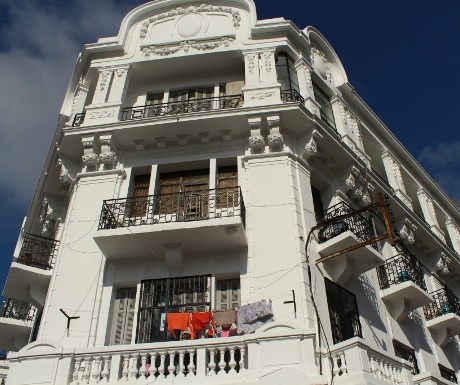 Casablanca was both blessed and cursed when a spectacularly successful Hollywood film bearing the same name came out in 1942. Now everyone knows the citys name, but few visitors to Morocco bother to know the city itself, especially if they are in search of timeless imperial capitals. And yet, for almost a century it has been Moroccos most important city: it is where modern Morocco was born.
Casablanca was both blessed and cursed when a spectacularly successful Hollywood film bearing the same name came out in 1942. Now everyone knows the citys name, but few visitors to Morocco bother to know the city itself, especially if they are in search of timeless imperial capitals. And yet, for almost a century it has been Moroccos most important city: it is where modern Morocco was born.
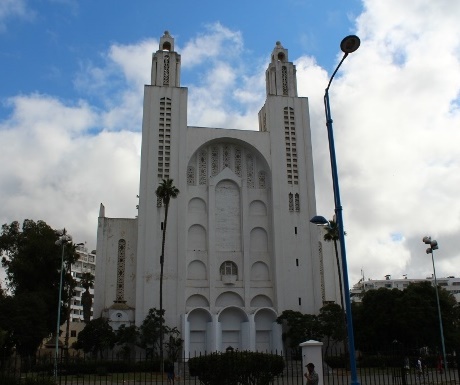 The real Casablanca as opposed to the Hollywood studio where the movie was actually filmed merits being seen, even on a global stage, as one of the birthplaces of modern architecture. It belongs to the same avant-garde family as the Brasilia of Oscar Niemeyer, the Marseille of Le Corbusier, or the Chicago of Louis Sullivan.
The real Casablanca as opposed to the Hollywood studio where the movie was actually filmed merits being seen, even on a global stage, as one of the birthplaces of modern architecture. It belongs to the same avant-garde family as the Brasilia of Oscar Niemeyer, the Marseille of Le Corbusier, or the Chicago of Louis Sullivan.
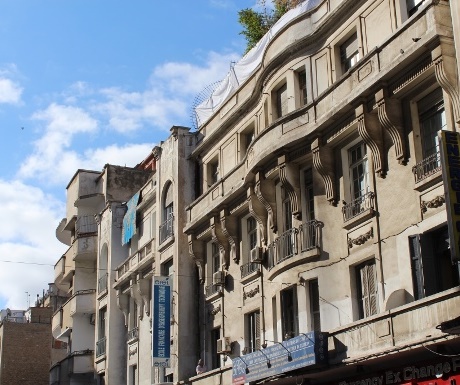 The real Casablanca is where people still come to find Moroccos American dream. For over a century Casablanca has offered hope to people wanting a new, more prosperous life. In the late 1800s Spanish artisans and fishermen came, followed by French traders, land speculators, and industrialists. Fleeing drought in the hinterland or bled, Muslims and Jews pitched up to trade and to work in sugar and cement factories. All shared the dream of acquiring new kinds of freedom.
The real Casablanca is where people still come to find Moroccos American dream. For over a century Casablanca has offered hope to people wanting a new, more prosperous life. In the late 1800s Spanish artisans and fishermen came, followed by French traders, land speculators, and industrialists. Fleeing drought in the hinterland or bled, Muslims and Jews pitched up to trade and to work in sugar and cement factories. All shared the dream of acquiring new kinds of freedom.
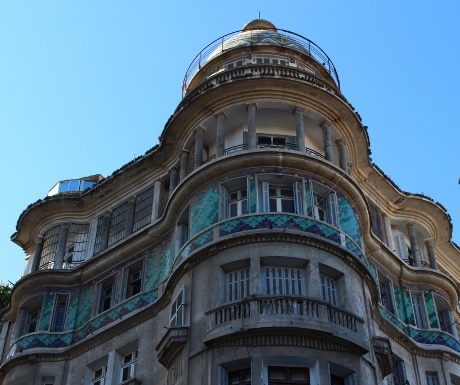 Casablancas buildings reflect this longing to be free from want, to be free to buy. Open to the intense sunlight and mild sea air, the buildings express optimism. They flaunt the stylistic innovations of their eras: Beaux Arts, Neo-Mauresque, Art Deco, Cubist, Brutalist, Post-Modern. When you walk along the citys streets and boulevards, you are strolling through an open-air museum of twentieth century architecture.
Casablancas buildings reflect this longing to be free from want, to be free to buy. Open to the intense sunlight and mild sea air, the buildings express optimism. They flaunt the stylistic innovations of their eras: Beaux Arts, Neo-Mauresque, Art Deco, Cubist, Brutalist, Post-Modern. When you walk along the citys streets and boulevards, you are strolling through an open-air museum of twentieth century architecture.
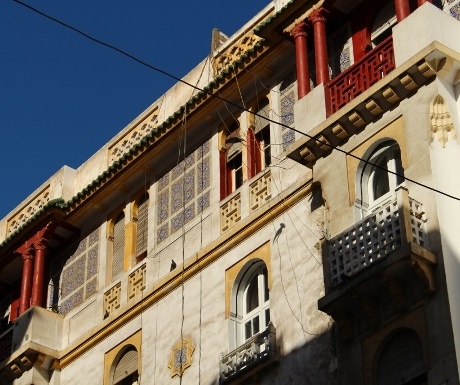 The ancienne médina or oldest part of the city is remarkable, not for its antiquity (its oldest structures date only from the late 1700s), but because it foretells the modern future of the entire city. It faces the sea. Its buildings dont turn in on themselves by presenting solid walls to the street. Large windows and balconies expose their interiors to the eyes of strangers. European traders and consuls who began flocking to the nineteenth century port were putting on display a new style of architecture. It appealed to wealthy Muslim and Jewish inhabitants of the quarter who set about building their own versions, albeit with Moorish touches like massive doorways and patios.
The ancienne médina or oldest part of the city is remarkable, not for its antiquity (its oldest structures date only from the late 1700s), but because it foretells the modern future of the entire city. It faces the sea. Its buildings dont turn in on themselves by presenting solid walls to the street. Large windows and balconies expose their interiors to the eyes of strangers. European traders and consuls who began flocking to the nineteenth century port were putting on display a new style of architecture. It appealed to wealthy Muslim and Jewish inhabitants of the quarter who set about building their own versions, albeit with Moorish touches like massive doorways and patios.
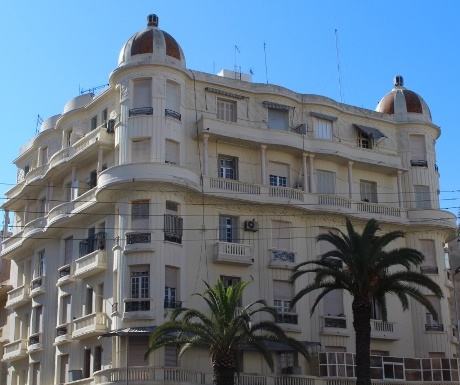 On the edge of the ancienne médina sits Ricks Café. Yes, that Ricks Café. It even has a piano player named Sam (actually Issam) who does play it again.
Walking away from the medina up Blvd. Hassan II, you arrive at a hub of action called Place Mohamed V. Pigeons are wheeling around a fountain where people scatter crumbs and vendors sell childrens toys. Officials pass in and out of the government buildings that bracket the Place. Construction of a monumental theatre is just beginning. Its not only a good place to sit and watch people such as children intent on steering electric toy cars. It also displays the shifting styles of public architecture erected by the French when they were building the protectorate they acquired in 1912.
Start with the Neo-Mauresque post office built in 1918; note its indigo tiles around the mail slots and the bi-plane cameo to the left of the entrance. Then look across the Place at the 1920 courthouse also inspired by the colored tiles and arcades of Moroccan architecture; these arcades, though, are untypically open to the street. Swing your eyes right to City Hall (1928) with its clock tower modeled on a minaret. Finally, look at the national bank (1937), bearing on its façade a sculpted rug, punctuated by five bold windows. In less than thirty years French architects had taken their admiration for Moroccan style in fresh directions that still please the eye. The Place, full of life, is also full of the history of a Franco-Moroccan encounter marked by mutual stylistic inspiration.
On the edge of the ancienne médina sits Ricks Café. Yes, that Ricks Café. It even has a piano player named Sam (actually Issam) who does play it again.
Walking away from the medina up Blvd. Hassan II, you arrive at a hub of action called Place Mohamed V. Pigeons are wheeling around a fountain where people scatter crumbs and vendors sell childrens toys. Officials pass in and out of the government buildings that bracket the Place. Construction of a monumental theatre is just beginning. Its not only a good place to sit and watch people such as children intent on steering electric toy cars. It also displays the shifting styles of public architecture erected by the French when they were building the protectorate they acquired in 1912.
Start with the Neo-Mauresque post office built in 1918; note its indigo tiles around the mail slots and the bi-plane cameo to the left of the entrance. Then look across the Place at the 1920 courthouse also inspired by the colored tiles and arcades of Moroccan architecture; these arcades, though, are untypically open to the street. Swing your eyes right to City Hall (1928) with its clock tower modeled on a minaret. Finally, look at the national bank (1937), bearing on its façade a sculpted rug, punctuated by five bold windows. In less than thirty years French architects had taken their admiration for Moroccan style in fresh directions that still please the eye. The Place, full of life, is also full of the history of a Franco-Moroccan encounter marked by mutual stylistic inspiration.
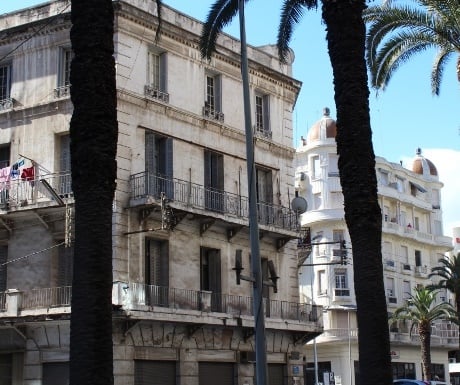 We may be seeing here the most benign side of imperialism: the liberty to shape a beautiful public space. The French military had formerly camped on this ground, so it belonged to the government; it was therefore available for development according to a unified vision. One man, Maréchal Hubert Lyautey, the first governor or resident of the French protectorate, is commonly credited with shaping that aesthetic vision, though he was aided by the work of countless others. He sits, now and forever, on his horse behind a fence on the grounds of the nearby French consulate. Try to find the spot where, before independence, he and his steed had overlooked his domain.
A seductive harmony also characterizesthe boulevard running from the edge of the medina to the main train station, Casa Voyageurs. Art Deco apartment buildings and stores are seamlessly linked to cubist ones. Rich Moroccans like Thami Glaoui and Omar Tazi seized the opportunity to join these architectural ventures and hired French architects like Marius Boyer (1885-1947) to design swank apartment buildings atop glass-roofed shopping malls. Boyer, one of the most prolific architects of his time, was also one of the most inventive. Within less than a decade, he would design such dissimilar buildings as a highly decorated neo-Mauresque newspaper office (1924) and a starkly avant-garde apartment block (1930), its three towers possessing the brand-new modern conveniences of garbage chutes, underground parking, and terraces galore.
We may be seeing here the most benign side of imperialism: the liberty to shape a beautiful public space. The French military had formerly camped on this ground, so it belonged to the government; it was therefore available for development according to a unified vision. One man, Maréchal Hubert Lyautey, the first governor or resident of the French protectorate, is commonly credited with shaping that aesthetic vision, though he was aided by the work of countless others. He sits, now and forever, on his horse behind a fence on the grounds of the nearby French consulate. Try to find the spot where, before independence, he and his steed had overlooked his domain.
A seductive harmony also characterizesthe boulevard running from the edge of the medina to the main train station, Casa Voyageurs. Art Deco apartment buildings and stores are seamlessly linked to cubist ones. Rich Moroccans like Thami Glaoui and Omar Tazi seized the opportunity to join these architectural ventures and hired French architects like Marius Boyer (1885-1947) to design swank apartment buildings atop glass-roofed shopping malls. Boyer, one of the most prolific architects of his time, was also one of the most inventive. Within less than a decade, he would design such dissimilar buildings as a highly decorated neo-Mauresque newspaper office (1924) and a starkly avant-garde apartment block (1930), its three towers possessing the brand-new modern conveniences of garbage chutes, underground parking, and terraces galore.
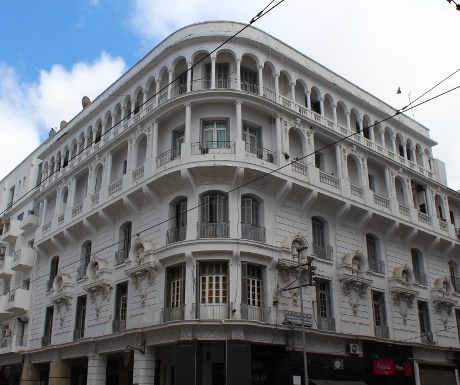 Taking a break from admiring this comfortingly coherent avenue, you can visit the Marché Central to eat oysters, or buy fish for grilling in a restaurant within the market.
Harmonious modernism. Architectural creativity. Mutual inspiration. Does this mean Casablanca is without blemish? Not at all. It is a blazingly white, concrete city built by factory workers. Today it numbers five million or more people and, of course, has its share of big city social problems. You need only watch two fine Moroccan films Ali Zaoua (2000) and Casanegra (2008) to begin to grasp them. Many parts of Casablanca look as if they need greater care. The once glamorous Hotel Lincoln, for example, overlooks the elegant new tramway line along Blvd. Mohammed V, but its surrounded by protective mesh because only its outer walls remain standing.
Fortunately there is an association dedicated to giving Casablanca the care, and the higher profile, it needs. Working in tandem with the citys government, Casamémoire, founded in 1995, is currently preparing an application to UNESCO asking for Casablanca to be declared a world heritage site. Casamémoire aims to raise public awareness of the citys beauties. The first weekend in April each year it creates a Heritage Days festival to honor the city. It offers free guided tours of neighborhoods the city center, industrial sites, worker housing, and traditional housing (Habous). In 2014 Casamémoire hosted for the first time a night-walk down a boulevard filled with street performers, thus celebrating the revival of a street once considered forbidding after dark.
Taking a break from admiring this comfortingly coherent avenue, you can visit the Marché Central to eat oysters, or buy fish for grilling in a restaurant within the market.
Harmonious modernism. Architectural creativity. Mutual inspiration. Does this mean Casablanca is without blemish? Not at all. It is a blazingly white, concrete city built by factory workers. Today it numbers five million or more people and, of course, has its share of big city social problems. You need only watch two fine Moroccan films Ali Zaoua (2000) and Casanegra (2008) to begin to grasp them. Many parts of Casablanca look as if they need greater care. The once glamorous Hotel Lincoln, for example, overlooks the elegant new tramway line along Blvd. Mohammed V, but its surrounded by protective mesh because only its outer walls remain standing.
Fortunately there is an association dedicated to giving Casablanca the care, and the higher profile, it needs. Working in tandem with the citys government, Casamémoire, founded in 1995, is currently preparing an application to UNESCO asking for Casablanca to be declared a world heritage site. Casamémoire aims to raise public awareness of the citys beauties. The first weekend in April each year it creates a Heritage Days festival to honor the city. It offers free guided tours of neighborhoods the city center, industrial sites, worker housing, and traditional housing (Habous). In 2014 Casamémoire hosted for the first time a night-walk down a boulevard filled with street performers, thus celebrating the revival of a street once considered forbidding after dark.
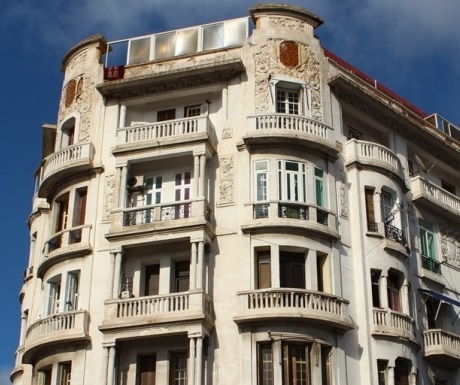 An adventurous traveler neednt stop loving the film. In Casablanca you can, like Sam, play the twentieth century again. It could be the beginning of a beautiful, twenty-first century friendship.
An adventurous traveler neednt stop loving the film. In Casablanca you can, like Sam, play the twentieth century again. It could be the beginning of a beautiful, twenty-first century friendship.
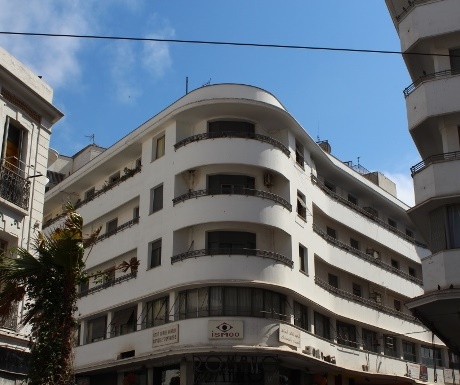 Cristian Martinus is Managing Director at Sun Trails.
If you would like to be a guest blogger on A Luxury Travel Blog in order to raise your profile, please contact us.
Cristian Martinus is Managing Director at Sun Trails.
If you would like to be a guest blogger on A Luxury Travel Blog in order to raise your profile, please contact us.Did you enjoy this article?
Receive similar content direct to your inbox.

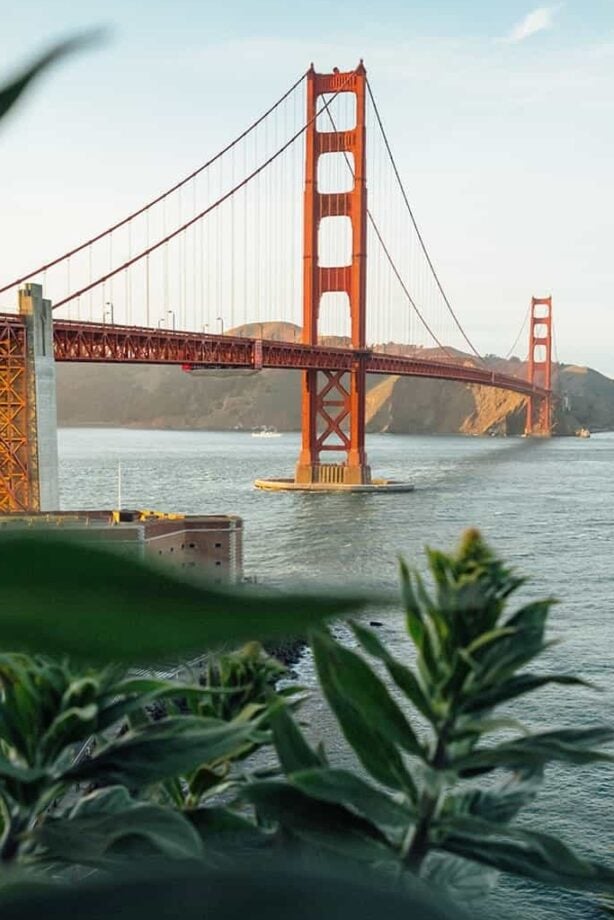
Casablanca is a modern city, it is well worth a tour.
the most visitors focus on the visit of the Hassan II Mosque and the Corniche.
Thank you for this article that shows us that there is so much to see in this city
Interesting article. Casablanca is a great and a large city. I think, it is one of the two most known Moroccan cities in the world. Casablanca and Marrakech. Casablanca gained worldwide popularity after the movie “Casablanca” which was published in 1942.
Thank you so much Cristian for the interesting article, it remembers with nostalgia the distant time of my childhood in Casablanca (60s). The Hebrew Normal School, Braided Shabbat Breads, Bar Mitzvah at the synagogue in the Mellah; the ancient Jewish quarter of the city.
I was born in Casablanca but moved to Israel then moved back couple of years ago to share my knowledge and experience of the Jewish heritage of Morocco with Jewish travelers from all over the world.
I agree when you say Casablanca rates always high on the bucket list of travelers to Morocco that needs private tours.
thanks a lot for sharing such a great article.
Casablanca is a big economic city and has stunning sites, it is well worth visiting.
the most visitors focus on the visit of the Hassan II Mosque and the Corniche.